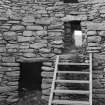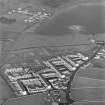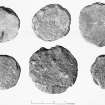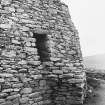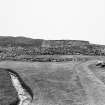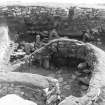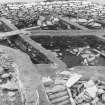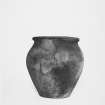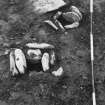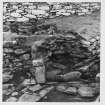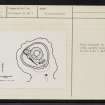Lerwick, South Road, Clickimin
Blockhouse (Iron Age), Broch (Iron Age), Enclosure (Iron Age), Fort (Prehistoric), Settlement (Prehistoric)
Site Name Lerwick, South Road, Clickimin
Classification Blockhouse (Iron Age), Broch (Iron Age), Enclosure (Iron Age), Fort (Prehistoric), Settlement (Prehistoric)
Alternative Name(s) Clickhimin; Loch Of Clickimin
Canmore ID 1049
Site Number HU44SE 2
NGR HU 46433 40815
Datum OSGB36 - NGR
Permalink http://canmore.org.uk/site/1049
First 100 images shown. See the Collections panel (below) for a link to all digital images.
- Council Shetland Islands
- Parish Lerwick
- Former Region Shetland Islands Area
- Former District Shetland
- Former County Shetland
Clickhimim, Shetland, footprint stone
Measurements:
Stone type: sandstone
Place of discovery: HU 4643 4081
Present location: set as a paving stone in the outer gateway leading into the fort with the footprints facing upwards.
Evidence for discovery: none, and the slab is unlikely to be in its original location.
Present condition: somewhat worn.
Description
Carved in low relief into the surface of the slab is a pair of shod footprints, set close together roughly in the centre of the slab. Each footprint is 0.23m long (9 inches).
Date: early medieval
References: Hamilton 1968, 151-6; Scott & Ritchie 2009, 2, 14, 47, no 10.
Compiled by A Ritchie 2016
HU44SE 2 46433 40815
(HU 4643 4082) Brough (NR)
O.S.6"map, Shetland, 2nd ed.,(1902).
The broch of Clickhimin, one of the best preserved broch sites in Shetland, was excavated between 1953 and 1957 by Hamilton, who recovered a history which shed new light on the Iron Age colonization of the area.
The earliest occupation of the site was a small Late Bronze Age farmstead of the 7th or 6th centuries BC which was superseded by a larger circular farmhouse built by Iron Age immigrants about the 5th century BC. In the 4th, or early 3rd century BC larger and well-organised bands of Celtic settlers arrived, capable of erecting a stone-walled fort consisting of a block-house and ringwork, which was in turn superseded by a broch about the 1st century AD. In the 2nd and 3rd centuries AD the need for such defences passed away and the subsequent history of the site centres round a large wheelhouse built within the reduced tower and with minor outhouses, storage pits and cattle stalls dug in the debris inside the older defences. 310: Two fragments of Roman glass were found, one 1st to early 2nd century AD and the other 2nd to mid-3rd century. Both came from wheelhouse deposits.
J R C Hamilton 1968
Resurveyed at 1/2500 by OS(RD) 8th September 1964.
Clickhimin Broch is situated on the south shore of the Loch of Clickhimin, three-quarters of a mile south-west of Lerwick on the Lerwick-Sumburgh road. Mousa Broch is situated on the west shore of the island of Mousa, opposite Sandwick, 15 miles south of Lerwick on the Lerwick-Sumburgh road. Access is by motor boat hired from Leebatten, Sandwick. These two monuments are open at all reasonable times on application to the Caretaker. The device on the outside of the cover is a stylised picture of a broch.
Bone dice found.
D V Clarke 1970; E J Mackie 1971.
Bronze Spiral finger-ring.
E J Mackie 1971.
A watching brief was carried out in advance of cables being laid for the installation of floodlights at Clickimin Broch. The trenches were dug by HBM workmen. The trenches averaged 0.2m wide and rarely exceeded 0.15m in depth. The nature of the disturbed deposits was recorded. Copies of the report have been deposited with RCAHMS, HBM, and the Shetland Archives.
V Turner 1990.
Field Visit (21 July 1930 - 4 July 1934)
Broch of Clickhimin. The freshwater loch of Clickhimin lies three-quarters of a mile SW of Lerwick, discharging through a short outlet into the sea at the Bight of Clickhimin on the W side of Brei Wick. On a promontory attached by a marshy neck of land to its S. shore stands the broch. Before 1874, according to Dryden's account, the site was a low rocky islet, connected to the mainland by a causeway. In that year the level of the water was lowered about 2 ft. 6 in., the islet becoming a peninsula and the causeway being left high and dry.
See RCAHMS 1946, iii, p.64-70, figs. 557-73, for a detailed description.
RCAHMS 1946, visited 21 July 1930 and 4 July 1934.
O.S.6"map, Shetland, 2nd ed.,(1902).
Measured Survey (July 1930)
RCAHMS surveyed the Broch of Clickhimin in July 1930 by plane-table and alidade. The resultant drawings were reproduced in ink and published at a reduced scale (RCAHMS 1946):
Fig. 557 - general plan at ground level (site)
Fig. 558 - general sections, and plans at upper levels (broch and forework)
Fig. 559 - sections of broch and forework
Fig. 573 - plan at level of gallery (after Dryden)
Excavation (1953 - 1957)
The broch of Clickhimin, one of the best preserved broch sites in Shetland, was excavated between 1953 and 1957 by Hamilton, who recovered a history which shed new light on the Iron Age colonization of the area.
The earliest occupation of the site was a small Late Bronze Age farmstead of the 7th or 6th centuries BC which was superseded by a larger circular farmhouse built by Iron Age immigrants about the 5th century BC. In the 4th, or early 3rd century BC larger and well-organised bands of Celtic settlers arrived, capable of erecting a stone-walled fort consisting of a block-house and ringwork, which was in turn superseded by a broch about the 1st century AD. In the 2nd and 3rd centuries AD the need for such defences passed away and the subsequent history of the site centres round a large wheelhouse built within the reduced tower and with minor outhouses, storage pits and cattle stalls dug in the debris inside the older defences. 310: Two fragments of Roman glass were found, one 1st to early 2nd century AD and the other 2nd to mid-3rd century. Both came from wheelhouse deposits.
J R C Hamilton 1968
Aerial Photography (1971)
Three oblique aerial photographs of Clickhimin, Shetland, taken by Mr John Dewar in 1971.















































































































